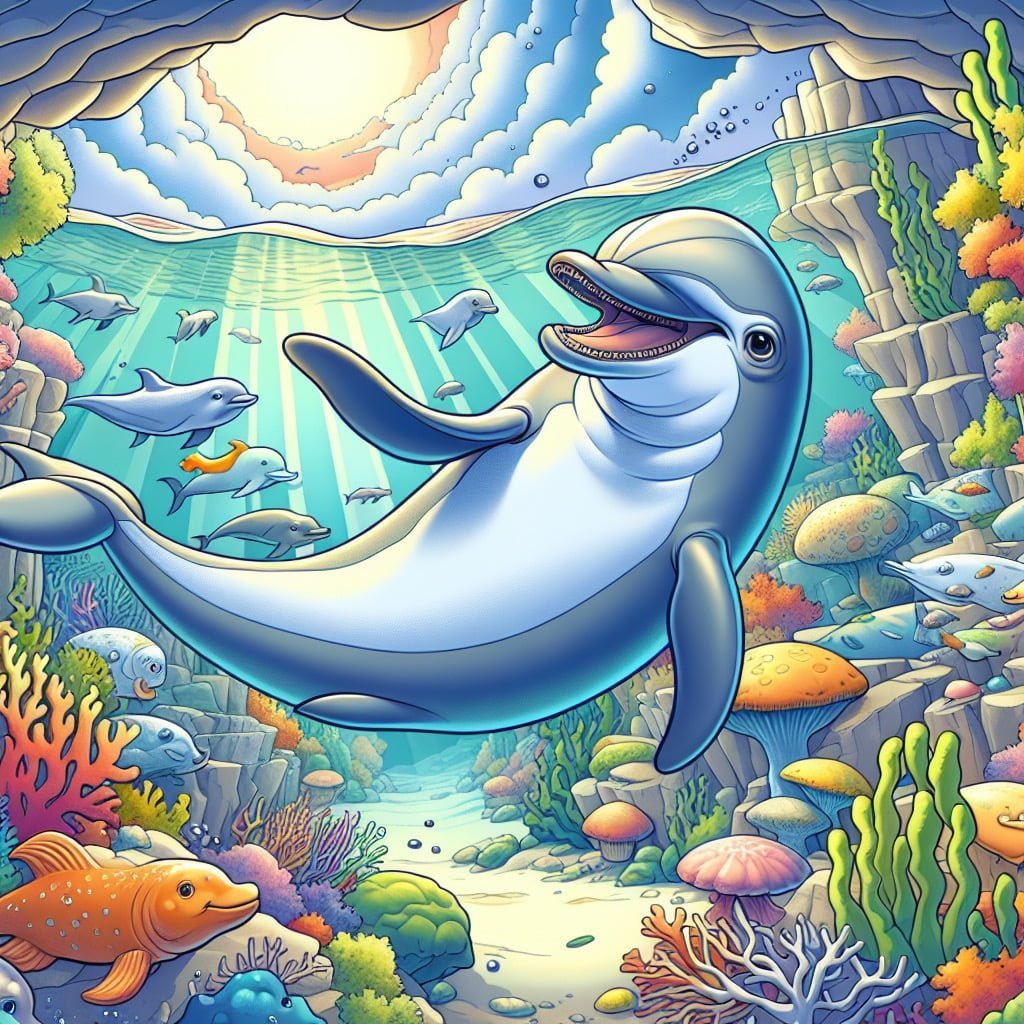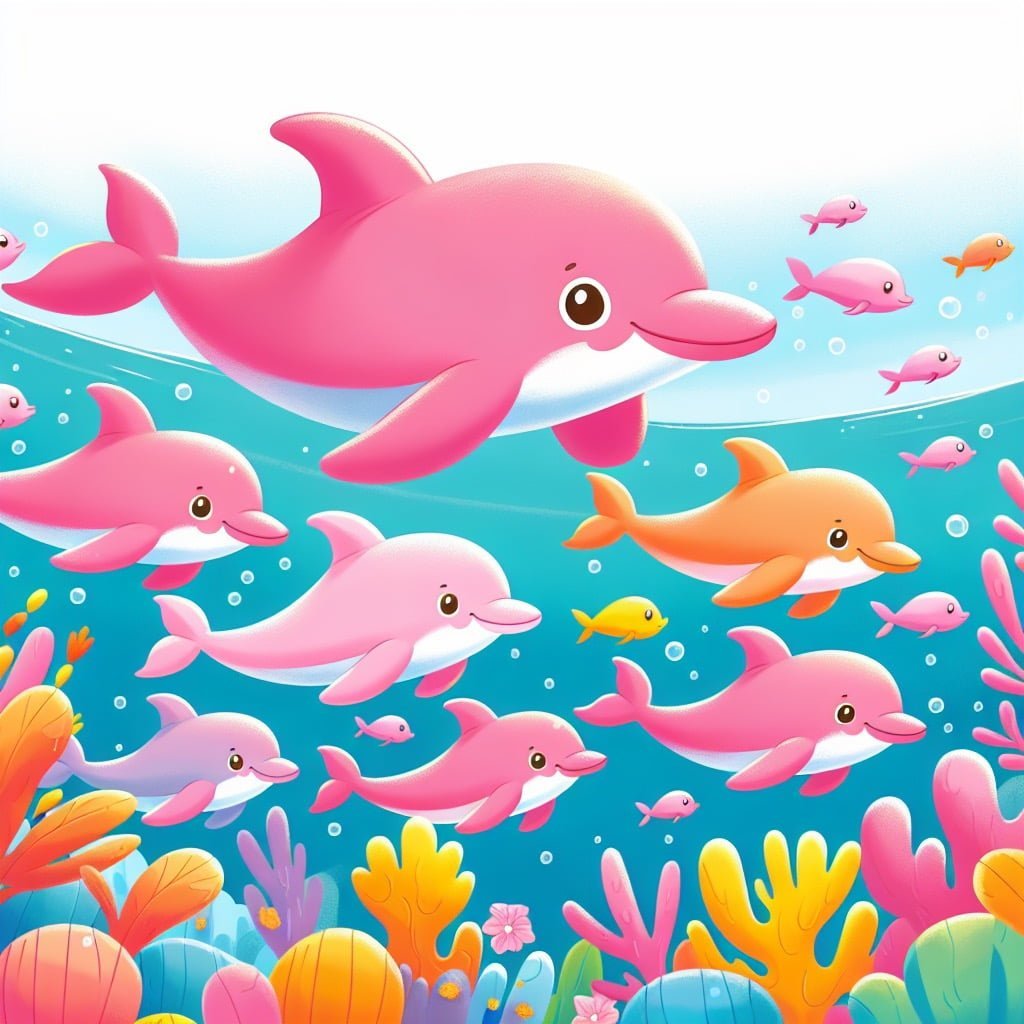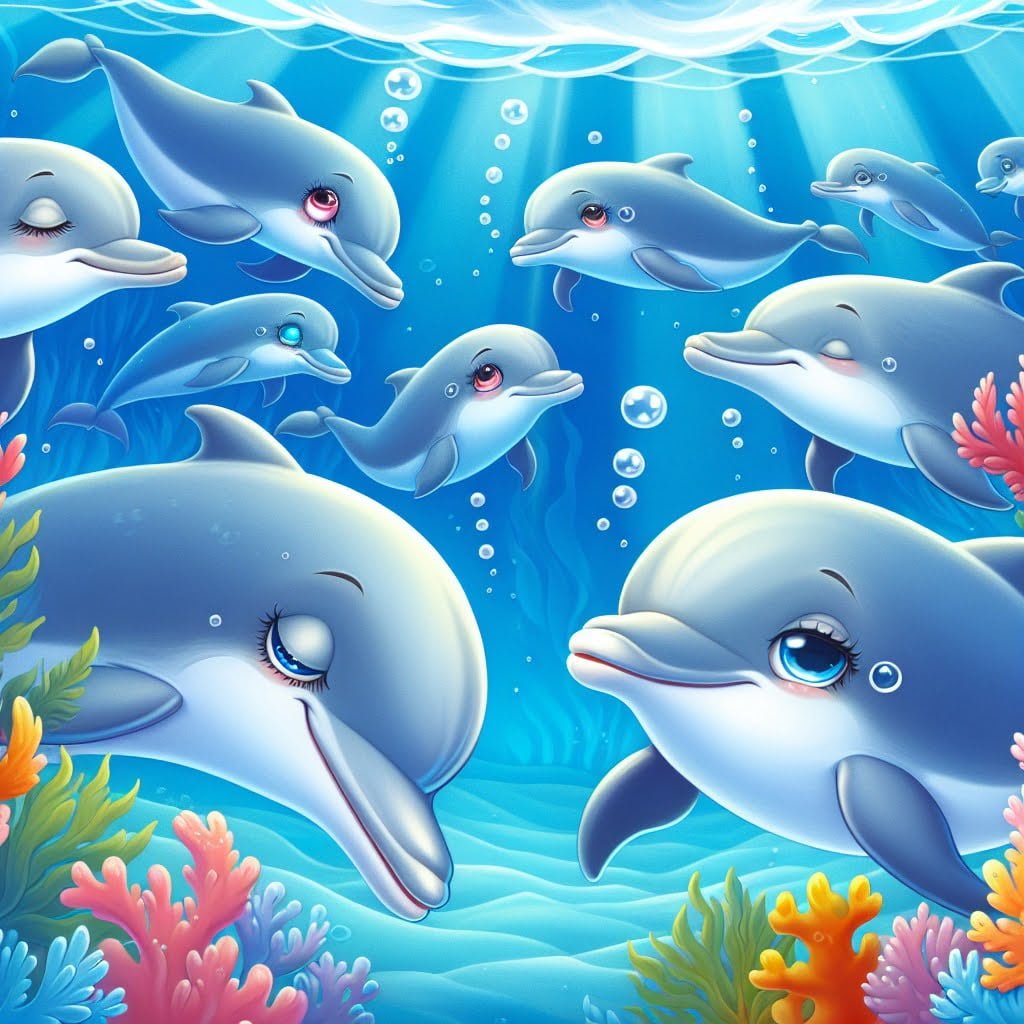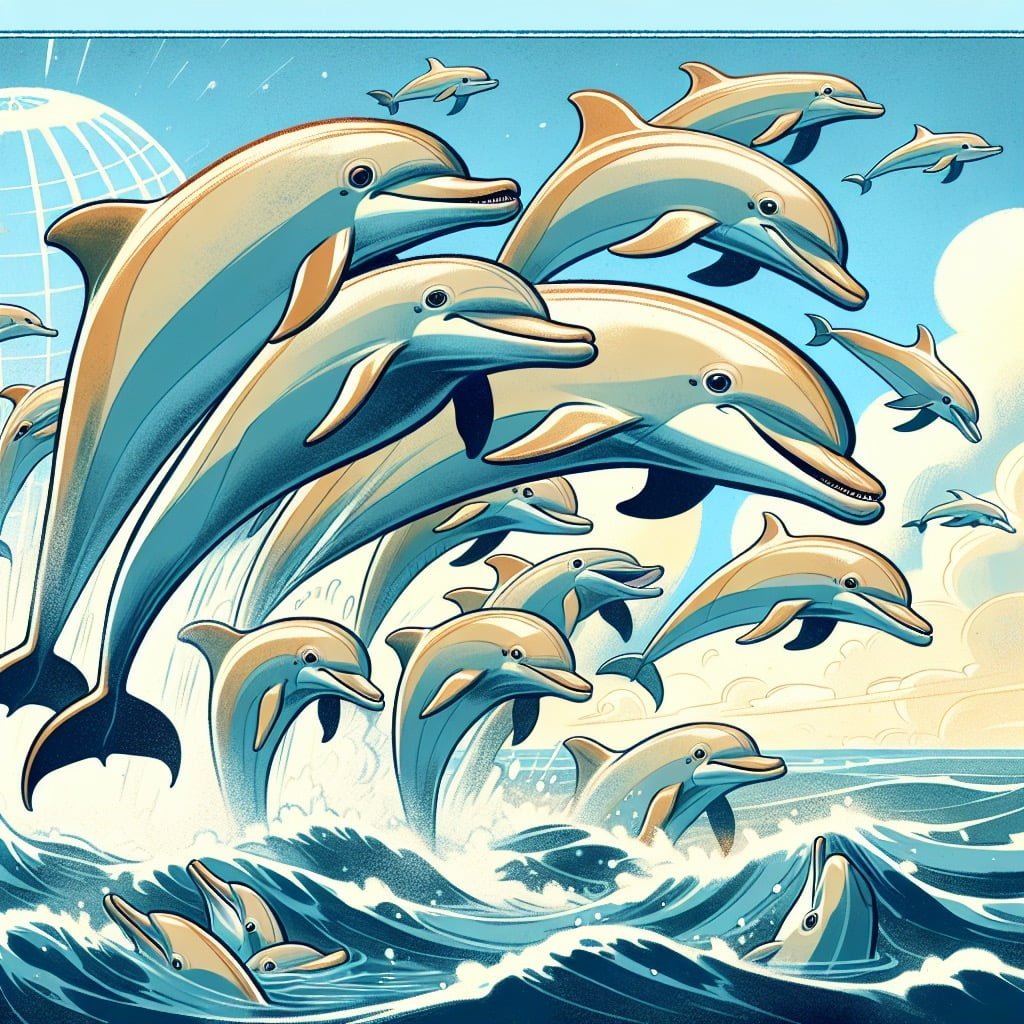Welcome to our blog post filled with fascinating Dolphin Facts For Kids! Dive into the world of these amazing marine mammals, from their unique communication skills to their playful behaviors and intelligence. Whether you’re a younger reader looking to learn about dolphin babies or an older reader interested in their echolocation abilities, you’ll discover something new and exciting about dolphins in each fun fact shared here. Join us on this educational journey as we explore the wonders of dolphins and their extraordinary lives in the ocean. Get ready to be amazed by these incredible creatures and their captivating behaviors. Let’s splash into the world of dolphins together!
Dolphin Facts For Kids
1. Dolphins Are Mammals, Not Fish

For younger kids: Dolphins are like us—they breathe air and give birth to live babies!
For older kids: Dolphins are classified as mammals because they nurse their young with milk, have hair at some stage of their life, and breathe air through blowholes on top of their heads.
Detailed explanation:Dolphins are fascinating creatures that have captured the hearts of many people around the world. One common misconception about dolphins is that they are fish, when in fact, they are mammals. This distinction is an important one to make, as it highlights the unique characteristics that set dolphins apart from fish.
One of the key features that categorizes dolphins as mammals is their method of reproduction. Like all mammals, female dolphins give birth to live young and nurse them with milk produced by mammary glands. This is in stark contrast to fish, which lay eggs and do not produce milk to feed their young. Additionally, dolphins have hair at some point in their life cycle, another trait that sets them apart from fish.
Dolphins also possess a complex respiratory system that is characteristic of mammals. They breathe air through blowholes located on the top of their heads, unlike fish which extract oxygen from water using gills. This is why dolphins need to come to the surface of the water periodically to breathe, as opposed to fish which extract oxygen from the water as it passes over their gills.
In conclusion, it is clear that dolphins are indeed mammals and not fish. By understanding this distinction, we can appreciate the unique characteristics of dolphins and gain a greater appreciation for these intelligent and sociable creatures. Remember, when teaching dolphin facts to kids, be sure to emphasize that dolphins are mammals, not fish.
Dolphin Facts For Kids
2. Dolphins Have Excellent Communication Skills

For younger kids: Dolphins talk to each other using sounds and body language!
For older kids: Dolphins are known for their complex communication skills, using clicks, whistles, and body movements to convey messages and form social bonds within their pods.
Detailed explanation:Dolphins are well-known for their incredible communication skills, which play a crucial role in their social bonds and group cohesion. These intelligent marine mammals use a variety of sounds, clicks, and whistles to convey messages to one another, with each sound having a specific meaning. For example, dolphins may emit high-pitched clicks to navigate underwater and locate prey using echolocation, a sophisticated form of communication that allows them to “see” in the dark ocean depths.
In addition to their impressive vocal communication, dolphins also engage in physical gestures and behaviors to express emotions and establish hierarchies within their groups. For instance, dolphins may engage in playful behaviors like tail slapping and synchronized swimming to strengthen social bonds and coordinate group movements while hunting or traveling together. These interactions demonstrate the dolphins’ social intelligence and ability to work together as a cohesive unit.
Furthermore, studies have shown that dolphins exhibit complex vocal learning similar to that of humans, as they are capable of mimicking sounds and developing unique “signature whistles” to identify themselves to others. This form of individualized communication helps dolphins recognize and communicate with specific group members, strengthening social connections and facilitating cooperative behaviors.
Overall, the communication skills of dolphins are truly remarkable and essential to their survival in the complex marine environment. By understanding and appreciating these fascinating Dolphin Facts For Kids, we can gain a deeper insight into the sophisticated social lives of these amazing creatures.
Dolphin Facts For Kids
3. Dolphins Have Excellent Eyesight Both In and Out of Water

For younger kids: Dolphins can see really well—they can even look in and out of the water!
For older kids: Dolphins have unique eyes that allow them to see clearly in and out of the water. Their eyes can detect colors, shapes, and movements both above the surface and below.
Detailed explanation:Dolphins are known for their exceptional eyesight, both in and out of the water. This remarkable ability allows them to navigate their marine environment with ease and hunt for prey efficiently.
Underwater, dolphins have adapted to see clearly despite the distortion caused by the water. Their eyes have specialized lenses that adjust to the refractive index of water, allowing them to focus and see clearly underwater. This unique adaptation gives them an advantage when hunting for fish, squid, and other small marine creatures in their ocean habitat.
Above water, dolphins can see objects from a great distance due to their excellent vision. They have the ability to see both near and far objects clearly, which is essential for communication, navigation, and detecting potential predators.
In addition to their exceptional eyesight, dolphins also possess another unique adaptation called echolocation. This ability allows them to “see” underwater by producing high-frequency sounds and listening to the echoes that bounce back. Echolocation helps dolphins navigate murky waters, locate prey, and communicate with each other effectively.
Overall, dolphins’ excellent eyesight both in and out of the water plays a crucial role in their survival and success in their marine environment. It is a fascinating aspect of their biology that showcases the remarkable adaptations of these intelligent and playful marine mammals.
In conclusion, Dolphin Facts For Kids are not only interesting but also educational, shedding light on the incredible abilities of these fascinating marine creatures.
Dolphin Facts For Kids
4. Some Dolphins Are Pink

For younger kids: There are dolphins that are pretty and pink, like magical creatures!
For older kids: Pink dolphins, also known as Amazon River dolphins, get their rosy hue from capillaries near the surface of their skin. The color can change due to excitement, temperature, or health.
Detailed explanation:Dolphins are fascinating marine mammals that captivate people of all ages. One intriguing fact about dolphins that many people may not be aware of is that some dolphins are actually pink in color. This unique characteristic can be found in certain species of dolphins, such as the albino bottlenose dolphin.
The pink coloration of some dolphins is due to a rare genetic mutation that affects the production of melanin, the pigment that gives skin its color. In the case of pink dolphins, the lack of melanin in their skin causes it to appear pink instead of the typical gray or blue color seen in most dolphin species.
One of the most well-known pink dolphins is the Amazon river dolphin, also known as the pink river dolphin or boto. These dolphins are native to the Amazon River basin in South America and are known for their striking pink coloration. The pink hue of these dolphins is thought to be a result of the tannins in the water interacting with their skin over time.
Pink dolphins are not only visually striking, but they also play an important role in their ecosystems. They are top predators in their habitats and help to maintain the balance of marine life in the rivers and oceans where they reside.
In conclusion, the fact that some dolphins are pink is a fascinating example of the diversity and uniqueness of the natural world. By learning more about these colorful creatures, both children and adults can gain a greater appreciation for the beauty and wonder of marine life. So, next time you see a pink dolphin, remember that it is not only a sight to behold, but also a valuable member of its aquatic community.
Dolphin Facts For Kids
5. Dolphins Are Incredibly Playful Creatures

For younger kids: Dolphins love to have fun—they play tag and leap out of water!
For older kids: Dolphins are known for their playful behaviors, such as riding waves, playing with objects like seaweed or bubbles, and engaging in acrobatic leaps called breaches.
Detailed explanation:Dolphins are known for their playful nature, which makes them incredibly endearing to both children and adults. These intelligent marine mammals engage in a wide range of playful behaviors, from riding waves and leaping out of the water to playing with objects such as seaweed or sticks. This natural inclination towards playfulness is not just for fun, but also serves important purposes for dolphins.
One of the main reasons dolphins engage in playful behaviors is for social bonding. Play allows dolphins to interact with one another in a non-aggressive manner, strengthening social relationships within their pods. This is especially important for young dolphins, as play helps them develop essential social skills and learn the rules of social interaction within their group. Through play, dolphins also establish hierarchies and boundaries within their pods, which helps maintain order and cohesion among group members.
In addition to social bonding, play also serves as a form of physical exercise for dolphins. Swimming and playing games helps dolphins build strength, agility, and coordination, which are crucial for hunting and survival in the wild. Playful activities also stimulate dolphins’ minds and keep them mentally sharp, contributing to their overall health and well-being.
Overall, the playful nature of dolphins is not just a fun fact for kids to enjoy, but a fundamental aspect of their behavior with important implications for their social dynamics and physical health. By observing dolphins at play, we gain a deeper appreciation for these fascinating creatures and their complex social lives.
Dolphin Facts For Kids
6. Dolphins Sleep With One Eye Open

For younger kids: Dolphins snooze with one eye open so they can watch for danger!
For older kids: Dolphins exhibit unihemispheric slow-wave sleep, where one hemisphere of their brain sleeps while the other remains awake. This allows them to rest while maintaining awareness of their surroundings.
Detailed explanation:Dolphins, known for their intelligence and playful nature, have some fascinating behaviors that set them apart from other marine animals. One particularly interesting fact about dolphins is that they sleep with one eye open. This may sound like something out of a spy movie, but for dolphins, it is a crucial survival mechanism.
As mammals, dolphins need to rest and sleep just like humans do. However, unlike humans who can completely shut down their brain and body during sleep, dolphins have to remain conscious to ensure they can breathe and stay safe from potential predators. By sleeping with one eye open, dolphins are able to keep half of their brain awake and alert while the other half rests.
This method of sleeping, known as unihemispheric slow-wave sleep, allows dolphins to continue swimming and surfacing for air even while they are resting. It also helps them stay aware of their surroundings and quickly respond to any threats that may arise. This unique ability demonstrates the incredible adaptability and survival skills of dolphins in their oceanic environment.
In addition to sleeping with one eye open, dolphins also have other interesting sleep habits, such as resting near the surface of the water or swimming in a group to protect each other while resting. These behaviors showcase the social bonds and complex communication systems that dolphins rely on to thrive in the wild.
Overall, the fact that dolphins sleep with one eye open highlights the amazing adaptations and behaviors of these intelligent marine mammals. By staying vigilant even during sleep, dolphins are able to rest safely and continue navigating the challenges of their ocean home.
Dolphin Facts For Kids
7. Dolphins Have An Echo-Location System

For younger kids: Dolphins make noises that bounce off things to help them find food and friends!
For older kids: Dolphins use echolocation, emitting clicks that bounce back to detect objects, navigate, communicate, and locate food underwater. This system helps them ‘see’ in dark or murky waters.
Detailed explanation:Dolphins, as highly intelligent and social marine mammals, possess a remarkable echo-location system that plays a crucial role in their daily lives. This system, also known as biosonar, allows dolphins to navigate through their underwater environments with exceptional precision and efficiency.
The echo-location system works by emitting high-frequency clicks or vocalizations into the water, which then bounce off objects and return to the dolphin as echoes. By processing the time it takes for these echoes to return and the differences in their intensity, dolphins can accurately determine the location, size, shape, and even the composition of objects in their surroundings.
This incredible ability to “see” using sound waves enables dolphins to locate prey, such as fish and squid, even in murky or dark waters where visibility is limited. It also helps them to communicate with each other over long distances, navigate through complex underwater landscapes, and avoid potential predators.
For young dolphins, developing and honing their echo-location skills is essential for their survival and successful integration into their social groups. As they grow and learn from their experiences, juvenile dolphins become adept at using this sensory mechanism to interact with their environment and other members of their pod.
In conclusion, the echo-location system of dolphins is a remarkable adaptation that showcases their advanced intelligence and sensory capabilities. By utilizing sound waves to “see” in their underwater world, dolphins demonstrate a level of sophistication that continues to fascinate scientists and inspire admiration in people of all ages, including children learning about fascinating Dolphin Facts For Kids.
Dolphin Facts For Kids
8. Bottlenose Dolphins Are Among the Most Intelligent Animals

For younger kids: Bottlenose dolphins are super smart—they can solve puzzles and learn tricks!
For older kids: Bottlenose dolphins rank high in intelligence among animals, displaying problem-solving skills, self-awareness, tool use, and the ability to learn complex behaviors through imitation.
Detailed explanation:Bottlenose dolphins are known to be among the most intelligent animals in the animal kingdom. This fact has fascinated researchers and the general public alike, as these marine mammals have displayed remarkable cognitive abilities in various studies and observations.
One key aspect of their intelligence is their advanced communication skills. Bottlenose dolphins are known to have a complex system of vocalizations, which they use to communicate with each other and navigate their environment. They can produce a wide range of sounds, including clicks, whistles, and pulsed sounds, each serving a different purpose. Researchers have even suggested that dolphins may have their own “language” with individual names for each other.
Additionally, bottlenose dolphins have demonstrated problem-solving abilities and the capacity for innovative behavior. They have been observed using tools, such as sponges to protect their rostrums while foraging on the seafloor, and working together in coordinated hunting strategies. This level of social cooperation and ingenuity indicates a high level of intelligence among these marine mammals.
Studies have also shown that bottlenose dolphins possess self-awareness, as evidenced by their ability to recognize themselves in mirrors. This is a trait that is thought to be indicative of higher intelligence and consciousness in animals.
Overall, the intelligence of bottlenose dolphins is a fascinating subject of study that continues to captivate researchers and enthusiasts alike. Their complex communication, problem-solving abilities, and self-awareness make them truly exceptional creatures in the underwater world.
Dolphin Facts For Kids
9. Dolphins Have Unique Personalities and Social Structures

For younger kids: Dolphins have friends and families, just like we do!
For older kids: Dolphins exhibit diverse personalities, form tight-knit social groups called pods, and engage in complex social behaviors like cooperation, teaching, and even mourning the loss of a pod member.
Detailed explanation:Dolphins are highly intelligent and social marine mammals that exhibit unique personalities and social structures. Just like humans, dolphins have distinct individual characteristics that shape their behavior and interactions within their pods. This aspect of their behavior has been studied extensively by researchers who have observed dolphins in the wild and in captivity.
In the wild, dolphins form complex social groups known as pods, which can consist of up to hundreds of individuals. Within these pods, dolphins develop strong bonds and relationships with one another. They exhibit behaviors such as cooperation, communication, and even playfulness, which demonstrate their social intelligence and complexity.
Interestingly, each dolphin has its own unique personality traits that influence its role within the pod. Some dolphins may be more dominant and assertive, while others may be more passive and nurturing. These differences in personality can affect how dolphins interact with one another, resolve conflicts, and make decisions within the group.
Research has also shown that dolphins have a sophisticated communication system that allows them to convey messages, emotions, and even establish social hierarchies within their pods. They use a combination of vocalizations, body language, and behavior to communicate with one another and coordinate group activities.
Overall, the study of dolphin personalities and social structures provides valuable insights into the complex social lives of these fascinating marine mammals. By understanding how dolphins interact and form relationships within their pods, researchers can gain a deeper appreciation for the intelligence and social complexity of these remarkable animals.
Dolphin Facts For Kids
10. Dolphins Are Fast Swimmers, Reaching Speeds Up to 20 mph

For younger kids: Dolphins are like underwater race cars—they zip through the ocean super fast!
For older kids: Dolphins are incredibly fast swimmers, reaching speeds of up to 20 miles per hour. Their streamlined bodies and powerful tails help them glide effortlessly through the water.
Detailed explanation:Dolphins are truly fascinating creatures, and one of the most impressive aspects of their biology is their incredible swimming abilities. It is estimated that dolphins can reach speeds of up to 20 miles per hour, making them some of the fastest marine animals in the ocean. This incredible speed is due to a combination of factors, including their streamlined bodies, powerful tails, and strong muscles.
One of the key adaptations that allow dolphins to reach such impressive speeds is their unique body shape. Dolphins have a sleek, torpedo-like body that is perfectly designed for cutting through the water with minimal resistance. This hydrodynamic shape helps them move efficiently through the water, allowing them to reach top speeds with ease.
In addition to their streamlined bodies, dolphins also have powerful tails that provide the thrust needed to propel them through the water. The muscles in a dolphin’s tail are incredibly strong, allowing them to generate a significant amount of force with each powerful stroke. This combination of speed and agility makes dolphins highly effective hunters, allowing them to quickly chase down prey and outmaneuver potential predators.
Overall, the fact that dolphins can reach speeds of up to 20 miles per hour is just one example of the amazing adaptations that these intelligent animals have developed. Whether they are hunting for food, playing with fellow pod members, or simply exploring their ocean environment, dolphins are truly impressive swimmers that never fail to captivate the imagination of dolphin facts for kids and adults alike.
Did you know?
Did you know that dolphins have been observed playing with bubbles they create by blowing air underwater?
Summary of Dolphin Facts For Kids
Dolphins are fascinating creatures that captivate people of all ages, but especially kids. In this blog post, we explore 10 fun and interesting facts about dolphins that are sure to spark the curiosity of young minds. From learning that dolphins are mammals, not fish, to discovering their excellent communication skills and unique personalities, there is so much to uncover about these intelligent marine animals. Kids will be amazed to find out about dolphins’ pink coloration, playful behaviors, and impressive swimming speeds. Additionally, they will be intrigued by how dolphins sleep with one eye open and use echolocation to navigate their underwater world. By delving into these incredible dolphin facts, children can gain a deeper appreciation for the wonders of the natural world and the diversity of marine life. So, if you want to ignite a sense of wonder and curiosity in your child, be sure to read more about Dolphin Facts For Kids in this engaging and informative blog post.
Sources and additional information for Dolphin Facts For Kids
WikipediaBritannicaSan Diego Zoo KidsThe Smithsonian InstitutionDK Find Out!Australian MuseumWorld Wildlife FundThe Nature ConservancyAnimal PlanetMonterey Bay AquariumPBS NatureSmithsonian’s National Zoo & Conservation Biology InstituteWorld Wildlife FundAnimal Diversity Web (University of Michigan)IUCN Red List of Threatened SpeciesThe Cornell Lab of Ornithology – All About BirdsNational Audubon SocietyEncyclopedia of LifeSeaWorld Parks & EntertainmentAustralian Museum – AnimalsEncyclopedia of Life




